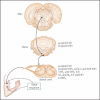Effectiveness of transcutaneous electrical nerve stimulation for treatment of hyperalgesia and pain
- PMID: 19007541
- PMCID: PMC2746624
- DOI: 10.1007/s11926-008-0080-z
Effectiveness of transcutaneous electrical nerve stimulation for treatment of hyperalgesia and pain
Abstract
Transcutaneous electrical nerve stimulation (TENS) is a nonpharmacologic treatment for pain relief. TENS has been used to treat a variety of painful conditions. This review updates the basic and clinical science regarding the use of TENS that has been published in the past 3 years (ie, 2005-2008). Basic science studies using animal models of inflammation show changes in the peripheral nervous system, as well as in the spinal cord and descending inhibitory pathways, in response to TENS. Translational studies show mechanisms to prevent analgesic tolerance to repeated application of TENS. This review also highlights data from recent randomized, placebo-controlled trials and current systematic reviews. Clinical trials suggest that adequate dosing, particularly intensity, is critical to obtaining pain relief with TENS. Thus, evidence continues to emerge from both basic science and clinical trials supporting the use of TENS for the treatment of a variety of painful conditions while identifying strategies to increase TENS effectiveness.
Figures

Similar articles
-
Transcutaneous electrical nerve stimulation reduces pain, fatigue and hyperalgesia while restoring central inhibition in primary fibromyalgia.Pain. 2013 Nov;154(11):2554-2562. doi: 10.1016/j.pain.2013.07.043. Epub 2013 Jul 27. Pain. 2013. PMID: 23900134 Free PMC article. Clinical Trial.
-
Reduction in inflammation-induced sensitization of dorsal horn neurons by transcutaneous electrical nerve stimulation in anesthetized rats.Exp Brain Res. 2001 Mar;137(1):94-102. doi: 10.1007/s002210000629. Exp Brain Res. 2001. PMID: 11310176
-
Transcutaneous electrical nerve stimulation: basic science mechanisms and clinical effectiveness.J Pain. 2003 Apr;4(3):109-21. doi: 10.1054/jpai.2003.434. J Pain. 2003. PMID: 14622708 Review.
-
Transcutaneous electrical nerve stimulation (TENS) reduces chronic hyperalgesia induced by muscle inflammation.Pain. 2006 Jan;120(1-2):182-187. doi: 10.1016/j.pain.2005.10.030. Epub 2005 Dec 19. Pain. 2006. PMID: 16360266
-
Transcutaneous Electrical Nerve Stimulation in Relieving Neuropathic Pain: Basic Mechanisms and Clinical Applications.Curr Pain Headache Rep. 2020 Feb 18;24(4):14. doi: 10.1007/s11916-020-0846-1. Curr Pain Headache Rep. 2020. PMID: 32072323 Review.
Cited by
-
Duration of Analgesia Induced by Acupuncture-Like TENS on Experimental Heat Pain.ISRN Pain. 2013 Apr 7;2013:792383. doi: 10.1155/2013/792383. eCollection 2013. ISRN Pain. 2013. PMID: 27335882 Free PMC article.
-
A comparison study of immune-inflammatory response in electroacupuncture and transcutaneous electrical nerve stimulation for patients undergoing supratentorial craniotomy.Int J Clin Exp Med. 2015 Jan 15;8(1):1156-61. eCollection 2015. Int J Clin Exp Med. 2015. PMID: 25785107 Free PMC article.
-
Attenuation of hypertension by C-fiber stimulation of the human median nerve and the concept-based novel device.Sci Rep. 2018 Oct 8;8(1):14967. doi: 10.1038/s41598-018-33402-1. Sci Rep. 2018. PMID: 30297735 Free PMC article. Clinical Trial.
-
Noninvasive vagus nerve stimulation as treatment for trigeminal allodynia.Pain. 2014 May;155(5):1037-1042. doi: 10.1016/j.pain.2014.02.009. Epub 2014 Feb 14. Pain. 2014. PMID: 24530613 Free PMC article.
-
The role of complementary and alternative methods in the treatment of pain in patients with cancer - current evidence and clinical practice: a narrative review.Contemp Oncol (Pozn). 2021;25(2):88-94. doi: 10.5114/wo.2021.105969. Epub 2021 May 7. Contemp Oncol (Pozn). 2021. PMID: 34667434 Free PMC article. Review.
References
-
- Sluka KA. The Neurobiology of pain and foundations for electrical stimulation. In: Robinson AJ, Snyder-Mackler L, editors. Clinical Electrophysiology. Lippincott Williams & Wilkins; Philadelphia: 2008. pp. 107–149. [• Of importanceA recent review of all the basic science mechanisms underlying TENS]
-
- Sluka KA, Deacon M, Stibal A, et al. Spinal blockade of opioid receptors prevents the analgesia produced by TENS in arthritic rats. J Pharmacol Exp Ther. 1999;289:840–846. - PubMed
-
- Kalra A, Urban MO, Sluka KA. Blockade of opioid receptors in rostral ventral medulla prevents antihyperalgesia produced by transcutaneous electrical nerve stimulation (TENS). J Pharmacol Exp Ther. 2001;298:257–263. - PubMed
-
- Sluka KA, Chandran P. Enhanced reduction in hyperalgesia by combined administration of clonidine and TENS. Pain. 2002;100:183–190. - PubMed
-
- Loeser JD, Treede RD. The Kyoto protocol of IASP Basic Pain Terminology. Pain. 2008 (in press) - PubMed
Publication types
MeSH terms
Grants and funding
LinkOut - more resources
Full Text Sources
Other Literature Sources
Medical
Miscellaneous
